Strategic Management Planning for Tesco: A Comprehensive Report
VerifiedAdded on 2022/11/28
|10
|2681
|500
Report
AI Summary
This report provides a detailed analysis of Tesco's strategic management planning. It begins with an introduction to strategic planning and its importance for organizations, particularly in the context of challenges like the COVID-19 pandemic. The main body of the report covers environmental analysis, including political, economic, social, technological, environmental, and legal factors impacting Tesco. It then explores the company's corporate and marketing objectives, including its mission, vision, and strategic goals. The report examines marketing strategy selection using the Boston Matrix and SWOT analysis. It further delves into market targeting and positioning using the STP approach, and discusses the 7 P's of marketing. Finally, the report addresses implementation, control, and evaluation, concluding with a summary of the key findings and recommendations. The report emphasizes the need for Tesco to adapt its strategies to the changing market conditions and leverage opportunities for growth, particularly in the digital realm and organic product offerings.
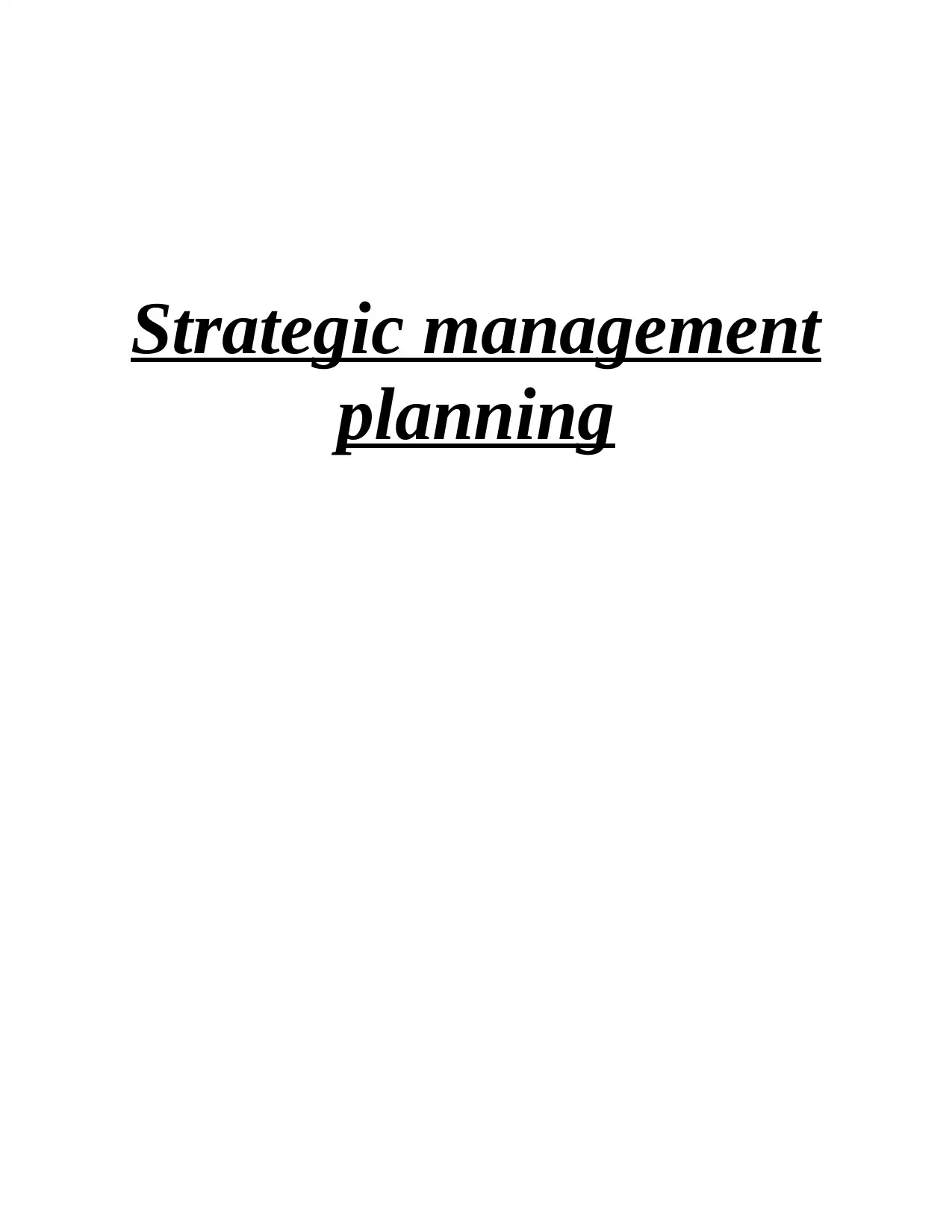
Strategic management
planning
planning
Paraphrase This Document
Need a fresh take? Get an instant paraphrase of this document with our AI Paraphraser
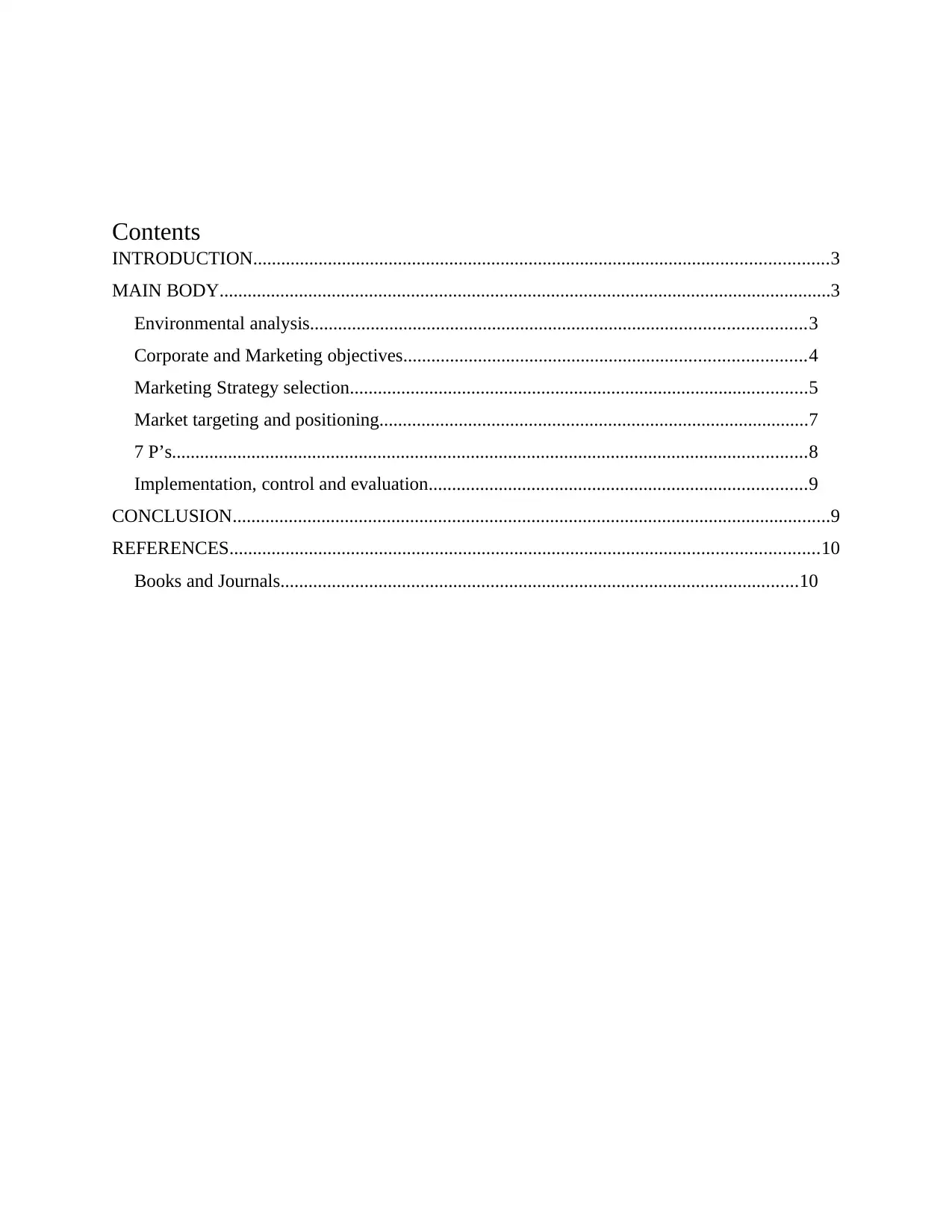
Contents
INTRODUCTION...........................................................................................................................3
MAIN BODY...................................................................................................................................3
Environmental analysis..........................................................................................................3
Corporate and Marketing objectives......................................................................................4
Marketing Strategy selection..................................................................................................5
Market targeting and positioning............................................................................................7
7 P’s........................................................................................................................................8
Implementation, control and evaluation.................................................................................9
CONCLUSION................................................................................................................................9
REFERENCES..............................................................................................................................10
Books and Journals...............................................................................................................10
INTRODUCTION...........................................................................................................................3
MAIN BODY...................................................................................................................................3
Environmental analysis..........................................................................................................3
Corporate and Marketing objectives......................................................................................4
Marketing Strategy selection..................................................................................................5
Market targeting and positioning............................................................................................7
7 P’s........................................................................................................................................8
Implementation, control and evaluation.................................................................................9
CONCLUSION................................................................................................................................9
REFERENCES..............................................................................................................................10
Books and Journals...............................................................................................................10
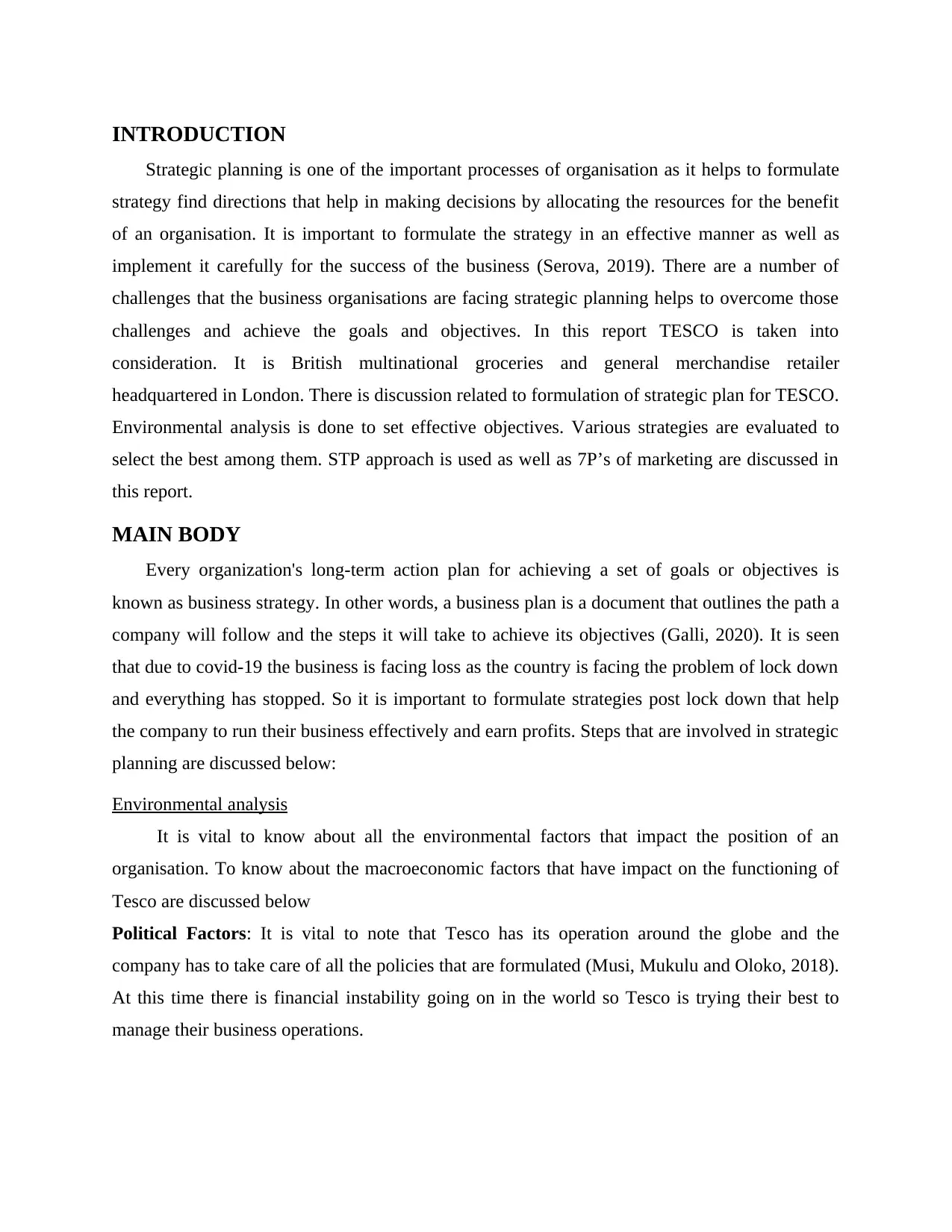
INTRODUCTION
Strategic planning is one of the important processes of organisation as it helps to formulate
strategy find directions that help in making decisions by allocating the resources for the benefit
of an organisation. It is important to formulate the strategy in an effective manner as well as
implement it carefully for the success of the business (Serova, 2019). There are a number of
challenges that the business organisations are facing strategic planning helps to overcome those
challenges and achieve the goals and objectives. In this report TESCO is taken into
consideration. It is British multinational groceries and general merchandise retailer
headquartered in London. There is discussion related to formulation of strategic plan for TESCO.
Environmental analysis is done to set effective objectives. Various strategies are evaluated to
select the best among them. STP approach is used as well as 7P’s of marketing are discussed in
this report.
MAIN BODY
Every organization's long-term action plan for achieving a set of goals or objectives is
known as business strategy. In other words, a business plan is a document that outlines the path a
company will follow and the steps it will take to achieve its objectives (Galli, 2020). It is seen
that due to covid-19 the business is facing loss as the country is facing the problem of lock down
and everything has stopped. So it is important to formulate strategies post lock down that help
the company to run their business effectively and earn profits. Steps that are involved in strategic
planning are discussed below:
Environmental analysis
It is vital to know about all the environmental factors that impact the position of an
organisation. To know about the macroeconomic factors that have impact on the functioning of
Tesco are discussed below
Political Factors: It is vital to note that Tesco has its operation around the globe and the
company has to take care of all the policies that are formulated (Musi, Mukulu and Oloko, 2018).
At this time there is financial instability going on in the world so Tesco is trying their best to
manage their business operations.
Strategic planning is one of the important processes of organisation as it helps to formulate
strategy find directions that help in making decisions by allocating the resources for the benefit
of an organisation. It is important to formulate the strategy in an effective manner as well as
implement it carefully for the success of the business (Serova, 2019). There are a number of
challenges that the business organisations are facing strategic planning helps to overcome those
challenges and achieve the goals and objectives. In this report TESCO is taken into
consideration. It is British multinational groceries and general merchandise retailer
headquartered in London. There is discussion related to formulation of strategic plan for TESCO.
Environmental analysis is done to set effective objectives. Various strategies are evaluated to
select the best among them. STP approach is used as well as 7P’s of marketing are discussed in
this report.
MAIN BODY
Every organization's long-term action plan for achieving a set of goals or objectives is
known as business strategy. In other words, a business plan is a document that outlines the path a
company will follow and the steps it will take to achieve its objectives (Galli, 2020). It is seen
that due to covid-19 the business is facing loss as the country is facing the problem of lock down
and everything has stopped. So it is important to formulate strategies post lock down that help
the company to run their business effectively and earn profits. Steps that are involved in strategic
planning are discussed below:
Environmental analysis
It is vital to know about all the environmental factors that impact the position of an
organisation. To know about the macroeconomic factors that have impact on the functioning of
Tesco are discussed below
Political Factors: It is vital to note that Tesco has its operation around the globe and the
company has to take care of all the policies that are formulated (Musi, Mukulu and Oloko, 2018).
At this time there is financial instability going on in the world so Tesco is trying their best to
manage their business operations.
⊘ This is a preview!⊘
Do you want full access?
Subscribe today to unlock all pages.

Trusted by 1+ million students worldwide
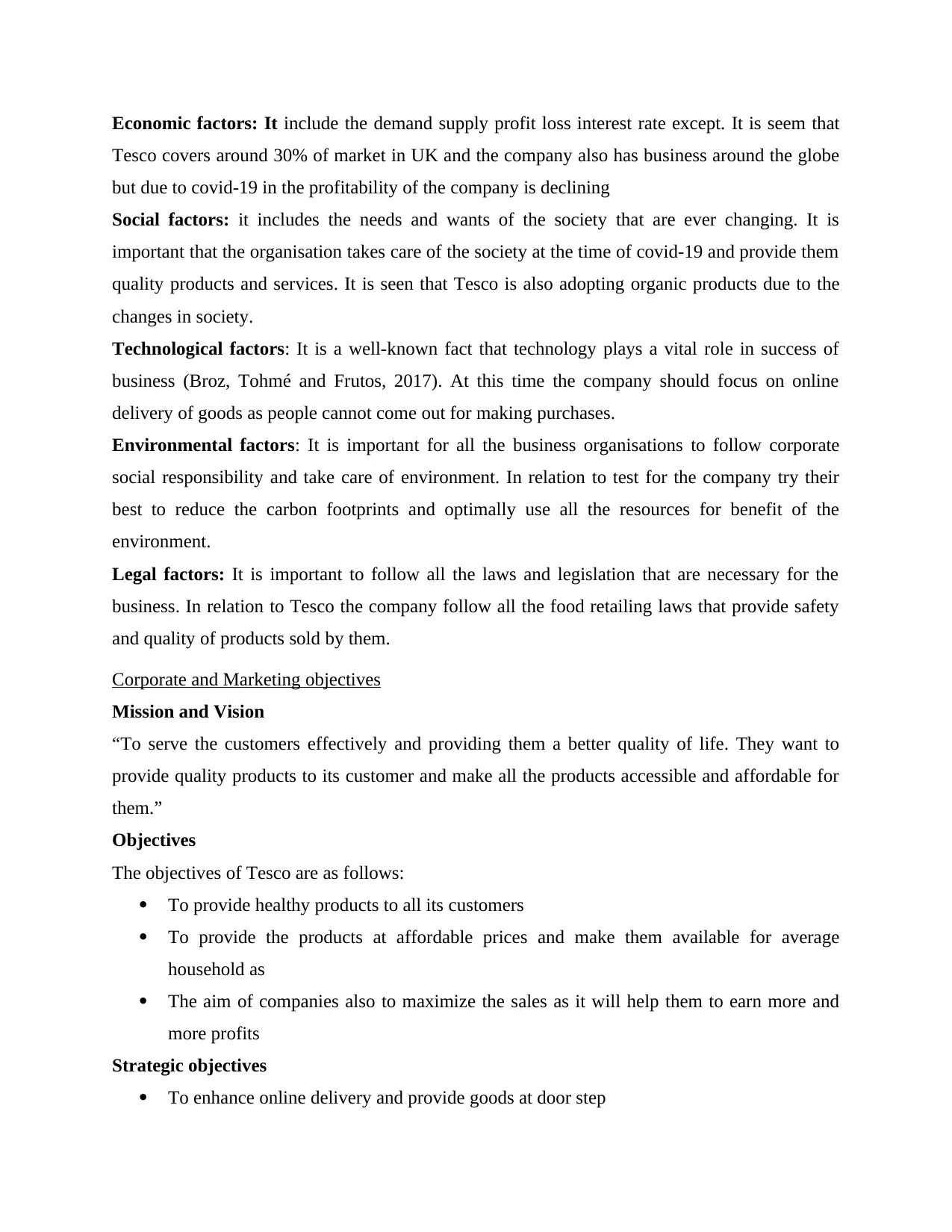
Economic factors: It include the demand supply profit loss interest rate except. It is seem that
Tesco covers around 30% of market in UK and the company also has business around the globe
but due to covid-19 in the profitability of the company is declining
Social factors: it includes the needs and wants of the society that are ever changing. It is
important that the organisation takes care of the society at the time of covid-19 and provide them
quality products and services. It is seen that Tesco is also adopting organic products due to the
changes in society.
Technological factors: It is a well-known fact that technology plays a vital role in success of
business (Broz, Tohmé and Frutos, 2017). At this time the company should focus on online
delivery of goods as people cannot come out for making purchases.
Environmental factors: It is important for all the business organisations to follow corporate
social responsibility and take care of environment. In relation to test for the company try their
best to reduce the carbon footprints and optimally use all the resources for benefit of the
environment.
Legal factors: It is important to follow all the laws and legislation that are necessary for the
business. In relation to Tesco the company follow all the food retailing laws that provide safety
and quality of products sold by them.
Corporate and Marketing objectives
Mission and Vision
“To serve the customers effectively and providing them a better quality of life. They want to
provide quality products to its customer and make all the products accessible and affordable for
them.”
Objectives
The objectives of Tesco are as follows:
To provide healthy products to all its customers
To provide the products at affordable prices and make them available for average
household as
The aim of companies also to maximize the sales as it will help them to earn more and
more profits
Strategic objectives
To enhance online delivery and provide goods at door step
Tesco covers around 30% of market in UK and the company also has business around the globe
but due to covid-19 in the profitability of the company is declining
Social factors: it includes the needs and wants of the society that are ever changing. It is
important that the organisation takes care of the society at the time of covid-19 and provide them
quality products and services. It is seen that Tesco is also adopting organic products due to the
changes in society.
Technological factors: It is a well-known fact that technology plays a vital role in success of
business (Broz, Tohmé and Frutos, 2017). At this time the company should focus on online
delivery of goods as people cannot come out for making purchases.
Environmental factors: It is important for all the business organisations to follow corporate
social responsibility and take care of environment. In relation to test for the company try their
best to reduce the carbon footprints and optimally use all the resources for benefit of the
environment.
Legal factors: It is important to follow all the laws and legislation that are necessary for the
business. In relation to Tesco the company follow all the food retailing laws that provide safety
and quality of products sold by them.
Corporate and Marketing objectives
Mission and Vision
“To serve the customers effectively and providing them a better quality of life. They want to
provide quality products to its customer and make all the products accessible and affordable for
them.”
Objectives
The objectives of Tesco are as follows:
To provide healthy products to all its customers
To provide the products at affordable prices and make them available for average
household as
The aim of companies also to maximize the sales as it will help them to earn more and
more profits
Strategic objectives
To enhance online delivery and provide goods at door step
Paraphrase This Document
Need a fresh take? Get an instant paraphrase of this document with our AI Paraphraser
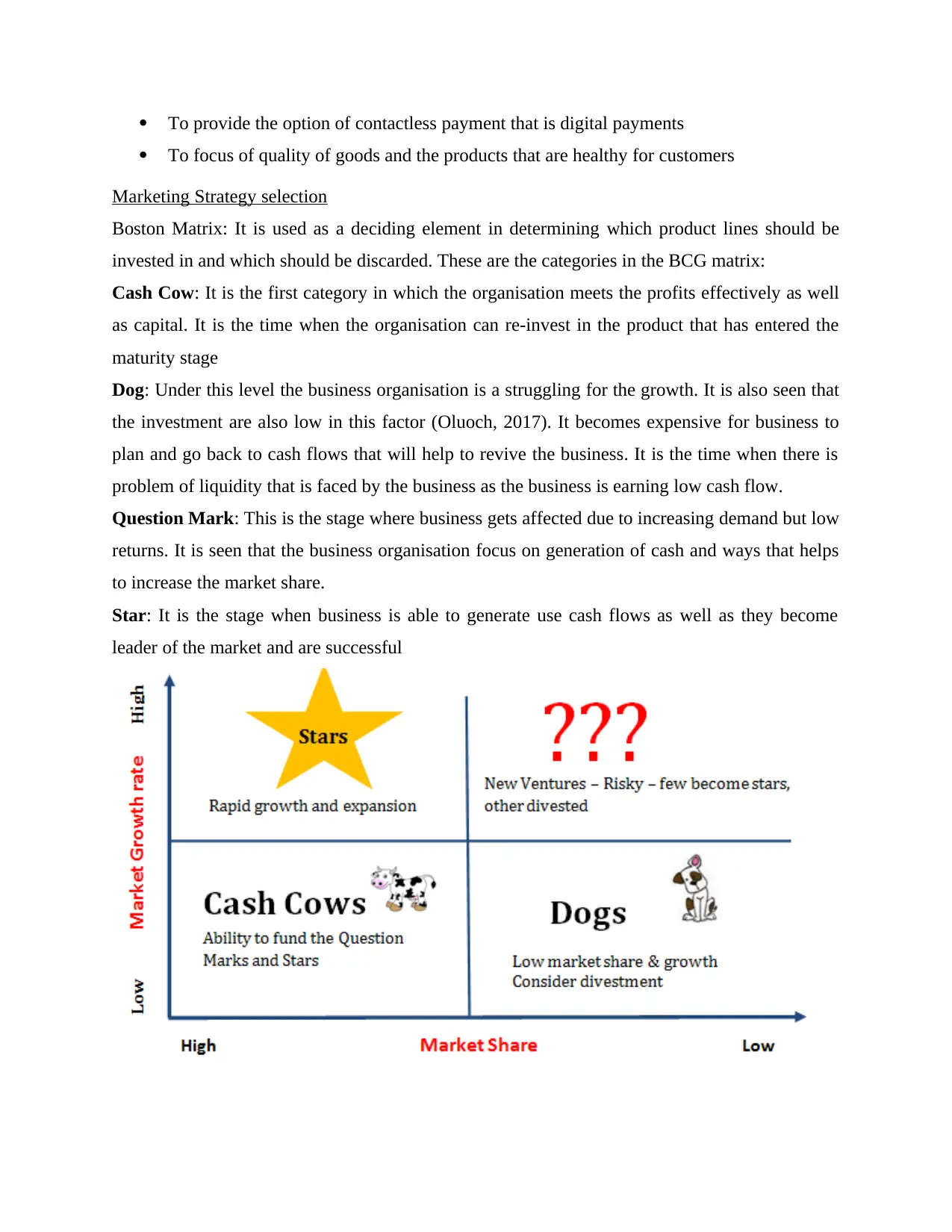
To provide the option of contactless payment that is digital payments
To focus of quality of goods and the products that are healthy for customers
Marketing Strategy selection
Boston Matrix: It is used as a deciding element in determining which product lines should be
invested in and which should be discarded. These are the categories in the BCG matrix:
Cash Cow: It is the first category in which the organisation meets the profits effectively as well
as capital. It is the time when the organisation can re-invest in the product that has entered the
maturity stage
Dog: Under this level the business organisation is a struggling for the growth. It is also seen that
the investment are also low in this factor (Oluoch, 2017). It becomes expensive for business to
plan and go back to cash flows that will help to revive the business. It is the time when there is
problem of liquidity that is faced by the business as the business is earning low cash flow.
Question Mark: This is the stage where business gets affected due to increasing demand but low
returns. It is seen that the business organisation focus on generation of cash and ways that helps
to increase the market share.
Star: It is the stage when business is able to generate use cash flows as well as they become
leader of the market and are successful
To focus of quality of goods and the products that are healthy for customers
Marketing Strategy selection
Boston Matrix: It is used as a deciding element in determining which product lines should be
invested in and which should be discarded. These are the categories in the BCG matrix:
Cash Cow: It is the first category in which the organisation meets the profits effectively as well
as capital. It is the time when the organisation can re-invest in the product that has entered the
maturity stage
Dog: Under this level the business organisation is a struggling for the growth. It is also seen that
the investment are also low in this factor (Oluoch, 2017). It becomes expensive for business to
plan and go back to cash flows that will help to revive the business. It is the time when there is
problem of liquidity that is faced by the business as the business is earning low cash flow.
Question Mark: This is the stage where business gets affected due to increasing demand but low
returns. It is seen that the business organisation focus on generation of cash and ways that helps
to increase the market share.
Star: It is the stage when business is able to generate use cash flows as well as they become
leader of the market and are successful
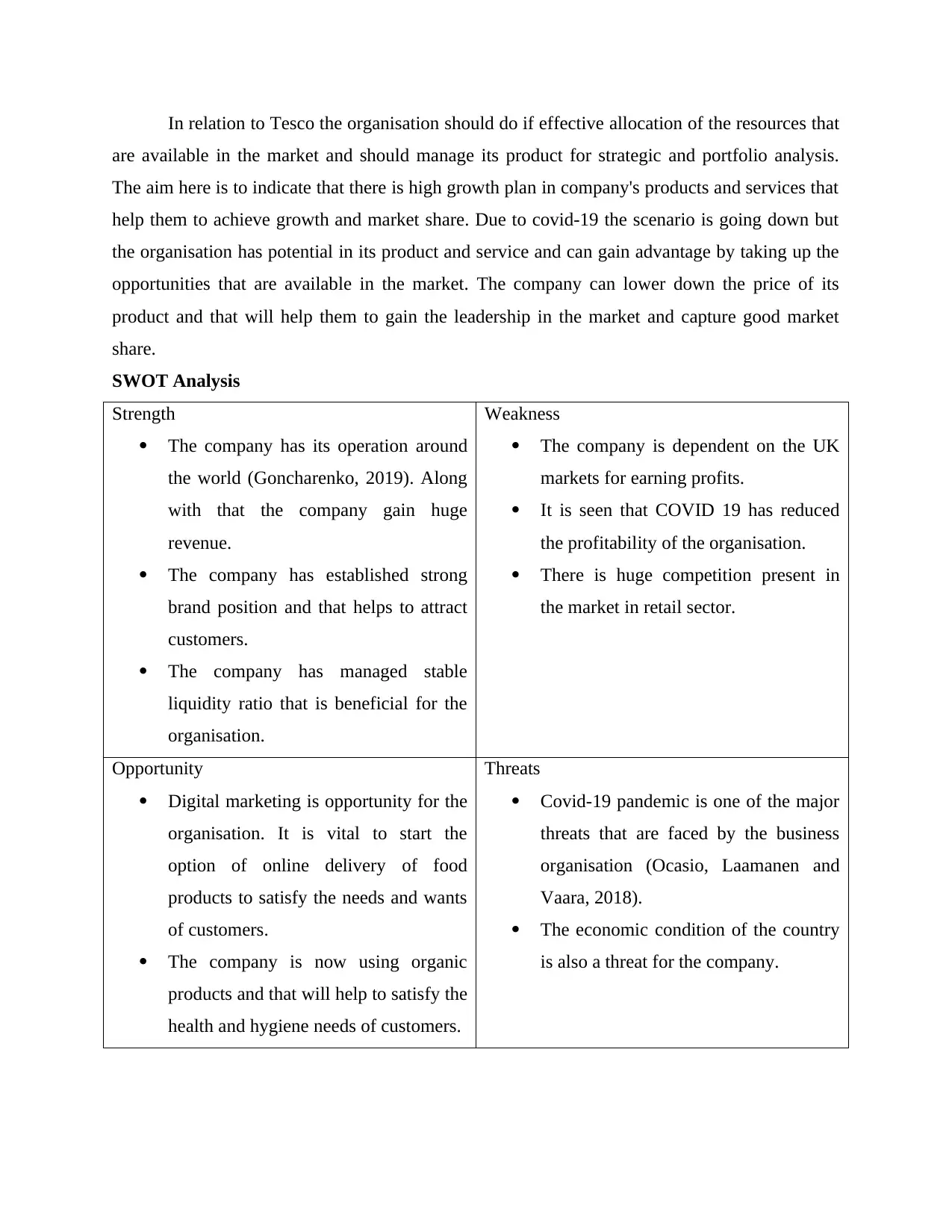
In relation to Tesco the organisation should do if effective allocation of the resources that
are available in the market and should manage its product for strategic and portfolio analysis.
The aim here is to indicate that there is high growth plan in company's products and services that
help them to achieve growth and market share. Due to covid-19 the scenario is going down but
the organisation has potential in its product and service and can gain advantage by taking up the
opportunities that are available in the market. The company can lower down the price of its
product and that will help them to gain the leadership in the market and capture good market
share.
SWOT Analysis
Strength
The company has its operation around
the world (Goncharenko, 2019). Along
with that the company gain huge
revenue.
The company has established strong
brand position and that helps to attract
customers.
The company has managed stable
liquidity ratio that is beneficial for the
organisation.
Weakness
The company is dependent on the UK
markets for earning profits.
It is seen that COVID 19 has reduced
the profitability of the organisation.
There is huge competition present in
the market in retail sector.
Opportunity
Digital marketing is opportunity for the
organisation. It is vital to start the
option of online delivery of food
products to satisfy the needs and wants
of customers.
The company is now using organic
products and that will help to satisfy the
health and hygiene needs of customers.
Threats
Covid-19 pandemic is one of the major
threats that are faced by the business
organisation (Ocasio, Laamanen and
Vaara, 2018).
The economic condition of the country
is also a threat for the company.
are available in the market and should manage its product for strategic and portfolio analysis.
The aim here is to indicate that there is high growth plan in company's products and services that
help them to achieve growth and market share. Due to covid-19 the scenario is going down but
the organisation has potential in its product and service and can gain advantage by taking up the
opportunities that are available in the market. The company can lower down the price of its
product and that will help them to gain the leadership in the market and capture good market
share.
SWOT Analysis
Strength
The company has its operation around
the world (Goncharenko, 2019). Along
with that the company gain huge
revenue.
The company has established strong
brand position and that helps to attract
customers.
The company has managed stable
liquidity ratio that is beneficial for the
organisation.
Weakness
The company is dependent on the UK
markets for earning profits.
It is seen that COVID 19 has reduced
the profitability of the organisation.
There is huge competition present in
the market in retail sector.
Opportunity
Digital marketing is opportunity for the
organisation. It is vital to start the
option of online delivery of food
products to satisfy the needs and wants
of customers.
The company is now using organic
products and that will help to satisfy the
health and hygiene needs of customers.
Threats
Covid-19 pandemic is one of the major
threats that are faced by the business
organisation (Ocasio, Laamanen and
Vaara, 2018).
The economic condition of the country
is also a threat for the company.
⊘ This is a preview!⊘
Do you want full access?
Subscribe today to unlock all pages.

Trusted by 1+ million students worldwide
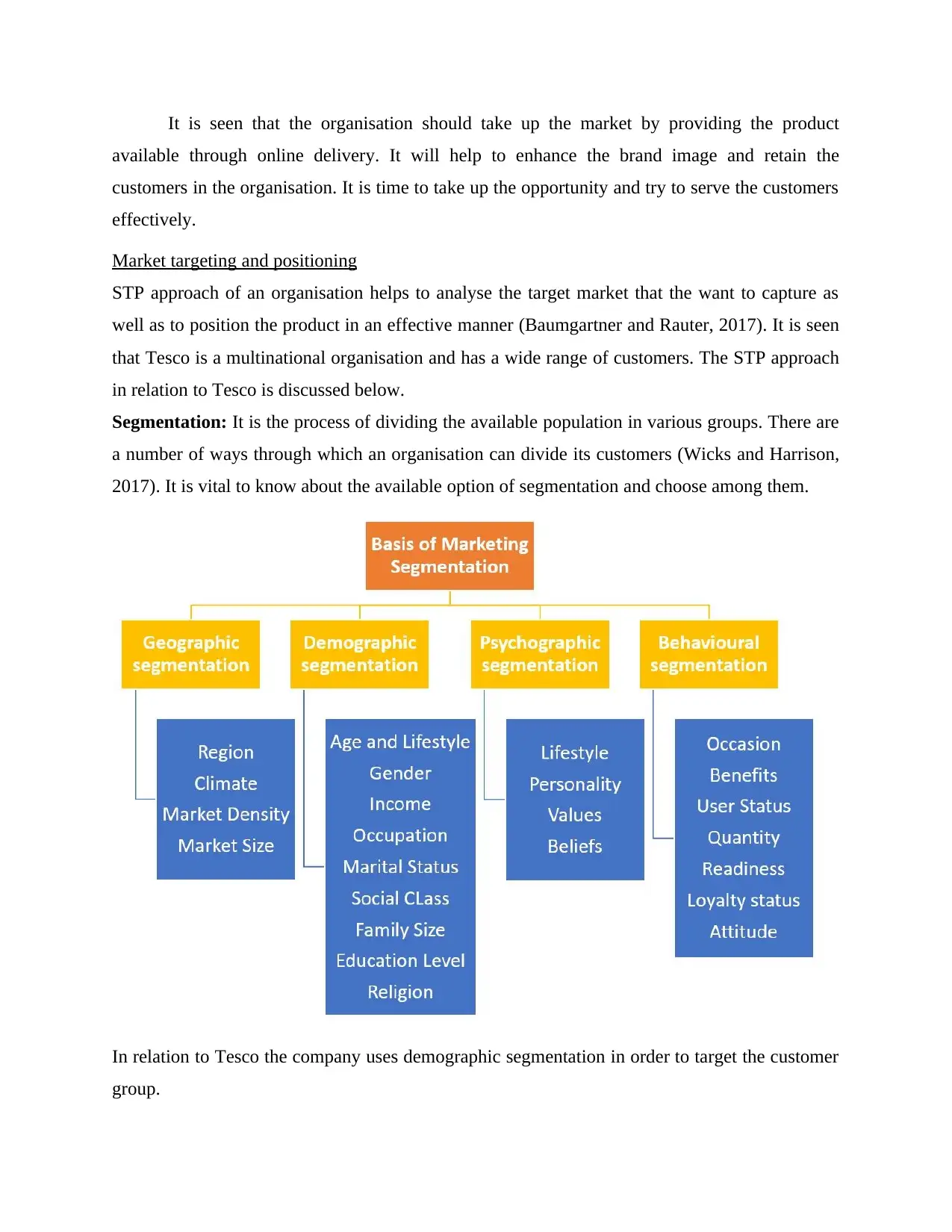
It is seen that the organisation should take up the market by providing the product
available through online delivery. It will help to enhance the brand image and retain the
customers in the organisation. It is time to take up the opportunity and try to serve the customers
effectively.
Market targeting and positioning
STP approach of an organisation helps to analyse the target market that the want to capture as
well as to position the product in an effective manner (Baumgartner and Rauter, 2017). It is seen
that Tesco is a multinational organisation and has a wide range of customers. The STP approach
in relation to Tesco is discussed below.
Segmentation: It is the process of dividing the available population in various groups. There are
a number of ways through which an organisation can divide its customers (Wicks and Harrison,
2017). It is vital to know about the available option of segmentation and choose among them.
In relation to Tesco the company uses demographic segmentation in order to target the customer
group.
available through online delivery. It will help to enhance the brand image and retain the
customers in the organisation. It is time to take up the opportunity and try to serve the customers
effectively.
Market targeting and positioning
STP approach of an organisation helps to analyse the target market that the want to capture as
well as to position the product in an effective manner (Baumgartner and Rauter, 2017). It is seen
that Tesco is a multinational organisation and has a wide range of customers. The STP approach
in relation to Tesco is discussed below.
Segmentation: It is the process of dividing the available population in various groups. There are
a number of ways through which an organisation can divide its customers (Wicks and Harrison,
2017). It is vital to know about the available option of segmentation and choose among them.
In relation to Tesco the company uses demographic segmentation in order to target the customer
group.
Paraphrase This Document
Need a fresh take? Get an instant paraphrase of this document with our AI Paraphraser
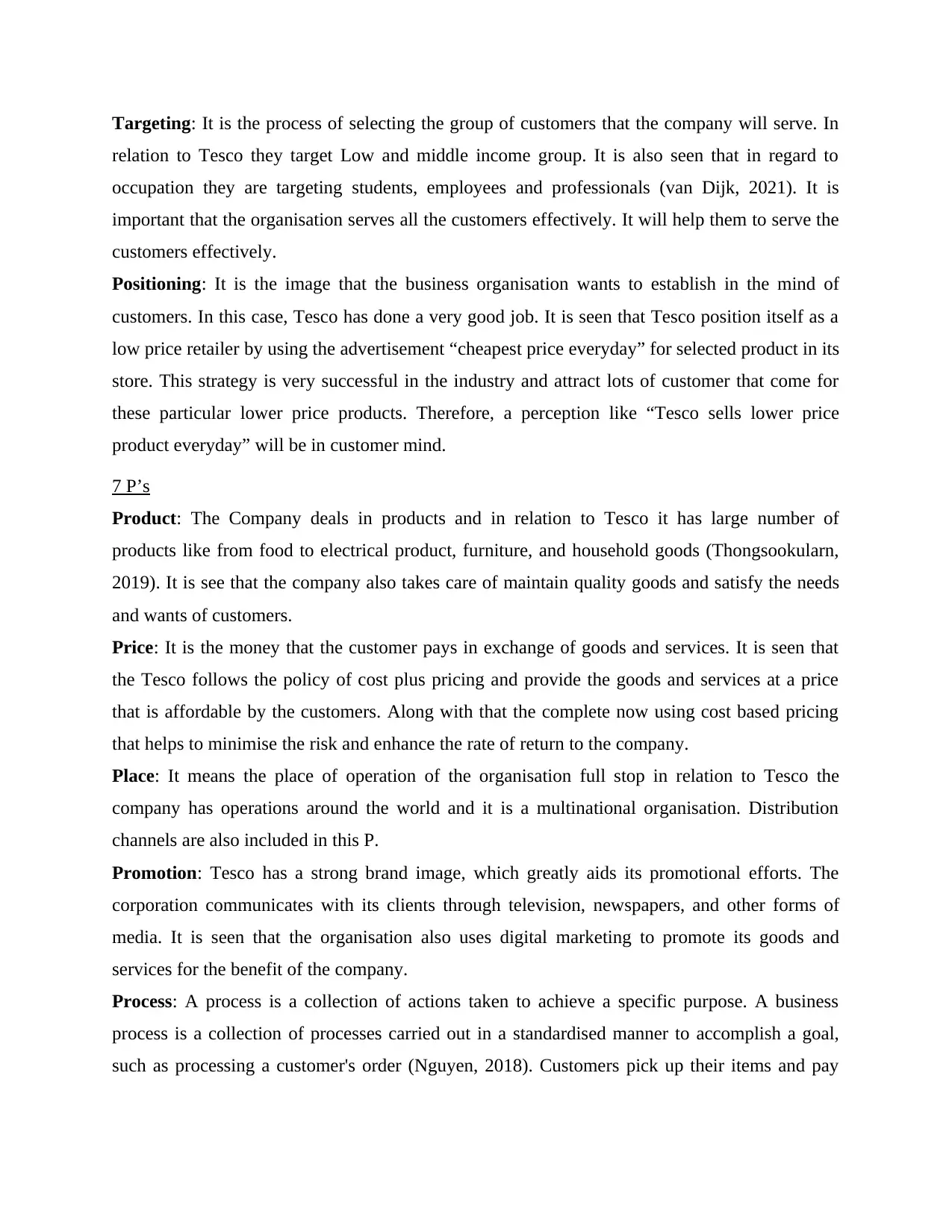
Targeting: It is the process of selecting the group of customers that the company will serve. In
relation to Tesco they target Low and middle income group. It is also seen that in regard to
occupation they are targeting students, employees and professionals (van Dijk, 2021). It is
important that the organisation serves all the customers effectively. It will help them to serve the
customers effectively.
Positioning: It is the image that the business organisation wants to establish in the mind of
customers. In this case, Tesco has done a very good job. It is seen that Tesco position itself as a
low price retailer by using the advertisement “cheapest price everyday” for selected product in its
store. This strategy is very successful in the industry and attract lots of customer that come for
these particular lower price products. Therefore, a perception like “Tesco sells lower price
product everyday” will be in customer mind.
7 P’s
Product: The Company deals in products and in relation to Tesco it has large number of
products like from food to electrical product, furniture, and household goods (Thongsookularn,
2019). It is see that the company also takes care of maintain quality goods and satisfy the needs
and wants of customers.
Price: It is the money that the customer pays in exchange of goods and services. It is seen that
the Tesco follows the policy of cost plus pricing and provide the goods and services at a price
that is affordable by the customers. Along with that the complete now using cost based pricing
that helps to minimise the risk and enhance the rate of return to the company.
Place: It means the place of operation of the organisation full stop in relation to Tesco the
company has operations around the world and it is a multinational organisation. Distribution
channels are also included in this P.
Promotion: Tesco has a strong brand image, which greatly aids its promotional efforts. The
corporation communicates with its clients through television, newspapers, and other forms of
media. It is seen that the organisation also uses digital marketing to promote its goods and
services for the benefit of the company.
Process: A process is a collection of actions taken to achieve a specific purpose. A business
process is a collection of processes carried out in a standardised manner to accomplish a goal,
such as processing a customer's order (Nguyen, 2018). Customers pick up their items and pay
relation to Tesco they target Low and middle income group. It is also seen that in regard to
occupation they are targeting students, employees and professionals (van Dijk, 2021). It is
important that the organisation serves all the customers effectively. It will help them to serve the
customers effectively.
Positioning: It is the image that the business organisation wants to establish in the mind of
customers. In this case, Tesco has done a very good job. It is seen that Tesco position itself as a
low price retailer by using the advertisement “cheapest price everyday” for selected product in its
store. This strategy is very successful in the industry and attract lots of customer that come for
these particular lower price products. Therefore, a perception like “Tesco sells lower price
product everyday” will be in customer mind.
7 P’s
Product: The Company deals in products and in relation to Tesco it has large number of
products like from food to electrical product, furniture, and household goods (Thongsookularn,
2019). It is see that the company also takes care of maintain quality goods and satisfy the needs
and wants of customers.
Price: It is the money that the customer pays in exchange of goods and services. It is seen that
the Tesco follows the policy of cost plus pricing and provide the goods and services at a price
that is affordable by the customers. Along with that the complete now using cost based pricing
that helps to minimise the risk and enhance the rate of return to the company.
Place: It means the place of operation of the organisation full stop in relation to Tesco the
company has operations around the world and it is a multinational organisation. Distribution
channels are also included in this P.
Promotion: Tesco has a strong brand image, which greatly aids its promotional efforts. The
corporation communicates with its clients through television, newspapers, and other forms of
media. It is seen that the organisation also uses digital marketing to promote its goods and
services for the benefit of the company.
Process: A process is a collection of actions taken to achieve a specific purpose. A business
process is a collection of processes carried out in a standardised manner to accomplish a goal,
such as processing a customer's order (Nguyen, 2018). Customers pick up their items and pay
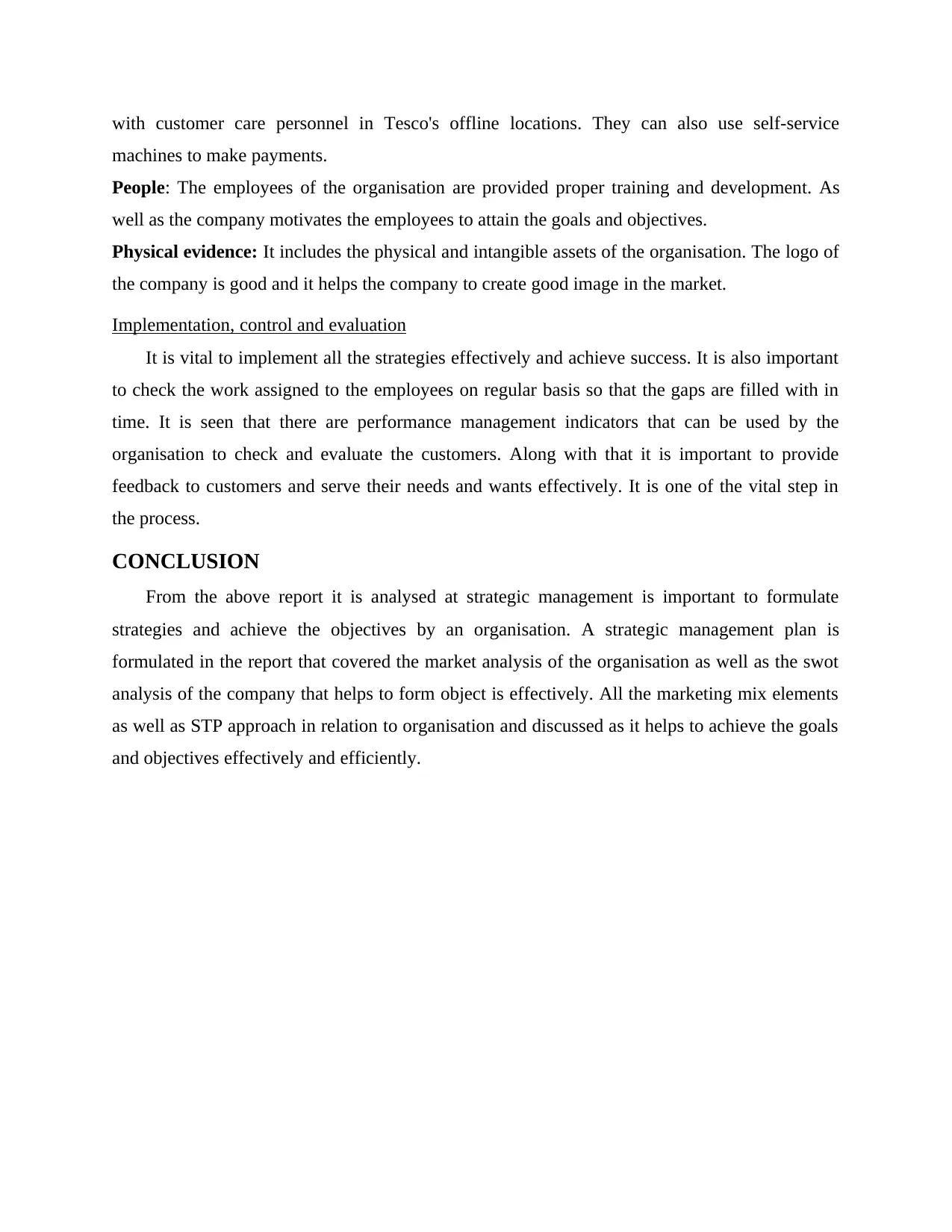
with customer care personnel in Tesco's offline locations. They can also use self-service
machines to make payments.
People: The employees of the organisation are provided proper training and development. As
well as the company motivates the employees to attain the goals and objectives.
Physical evidence: It includes the physical and intangible assets of the organisation. The logo of
the company is good and it helps the company to create good image in the market.
Implementation, control and evaluation
It is vital to implement all the strategies effectively and achieve success. It is also important
to check the work assigned to the employees on regular basis so that the gaps are filled with in
time. It is seen that there are performance management indicators that can be used by the
organisation to check and evaluate the customers. Along with that it is important to provide
feedback to customers and serve their needs and wants effectively. It is one of the vital step in
the process.
CONCLUSION
From the above report it is analysed at strategic management is important to formulate
strategies and achieve the objectives by an organisation. A strategic management plan is
formulated in the report that covered the market analysis of the organisation as well as the swot
analysis of the company that helps to form object is effectively. All the marketing mix elements
as well as STP approach in relation to organisation and discussed as it helps to achieve the goals
and objectives effectively and efficiently.
machines to make payments.
People: The employees of the organisation are provided proper training and development. As
well as the company motivates the employees to attain the goals and objectives.
Physical evidence: It includes the physical and intangible assets of the organisation. The logo of
the company is good and it helps the company to create good image in the market.
Implementation, control and evaluation
It is vital to implement all the strategies effectively and achieve success. It is also important
to check the work assigned to the employees on regular basis so that the gaps are filled with in
time. It is seen that there are performance management indicators that can be used by the
organisation to check and evaluate the customers. Along with that it is important to provide
feedback to customers and serve their needs and wants effectively. It is one of the vital step in
the process.
CONCLUSION
From the above report it is analysed at strategic management is important to formulate
strategies and achieve the objectives by an organisation. A strategic management plan is
formulated in the report that covered the market analysis of the organisation as well as the swot
analysis of the company that helps to form object is effectively. All the marketing mix elements
as well as STP approach in relation to organisation and discussed as it helps to achieve the goals
and objectives effectively and efficiently.
⊘ This is a preview!⊘
Do you want full access?
Subscribe today to unlock all pages.

Trusted by 1+ million students worldwide
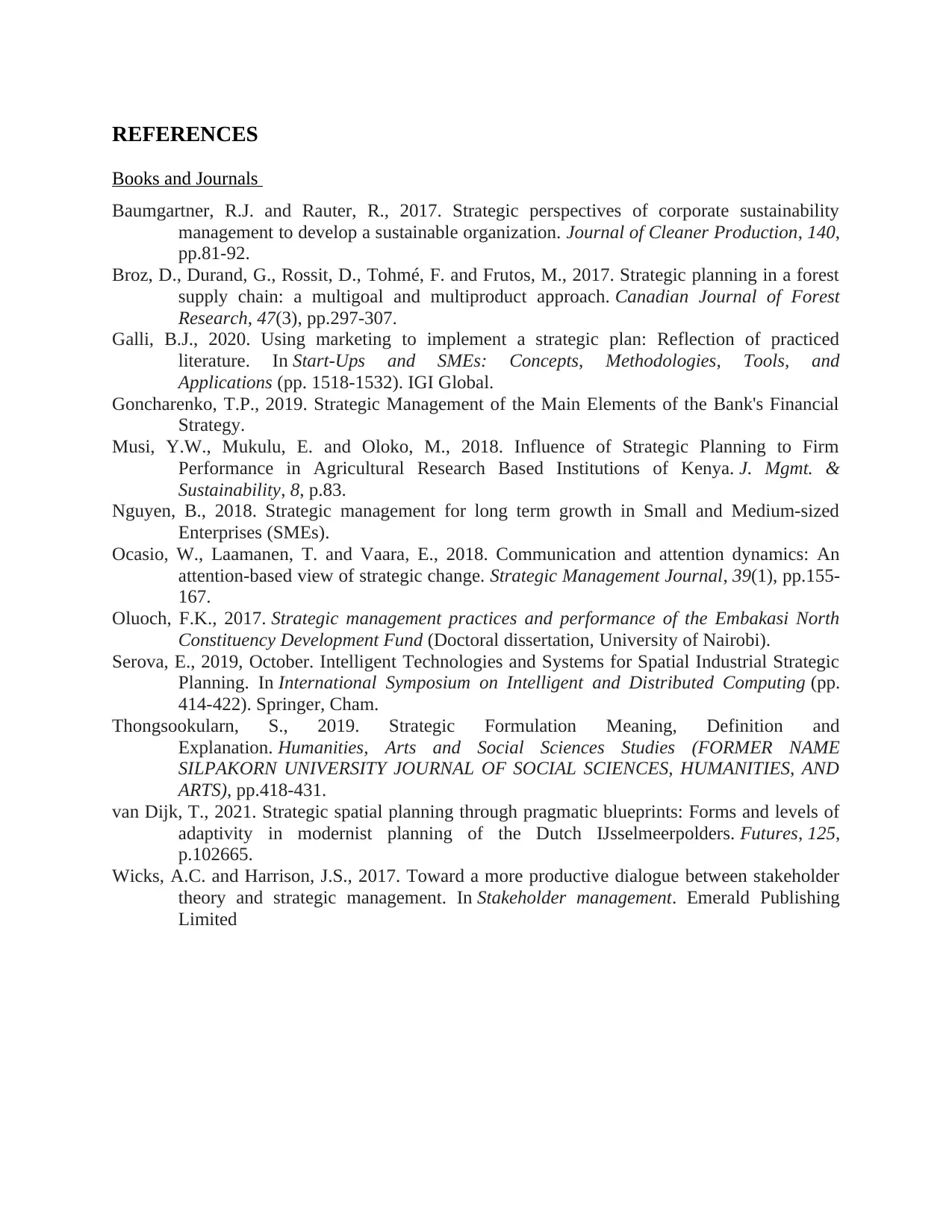
REFERENCES
Books and Journals
Baumgartner, R.J. and Rauter, R., 2017. Strategic perspectives of corporate sustainability
management to develop a sustainable organization. Journal of Cleaner Production, 140,
pp.81-92.
Broz, D., Durand, G., Rossit, D., Tohmé, F. and Frutos, M., 2017. Strategic planning in a forest
supply chain: a multigoal and multiproduct approach. Canadian Journal of Forest
Research, 47(3), pp.297-307.
Galli, B.J., 2020. Using marketing to implement a strategic plan: Reflection of practiced
literature. In Start-Ups and SMEs: Concepts, Methodologies, Tools, and
Applications (pp. 1518-1532). IGI Global.
Goncharenko, T.P., 2019. Strategic Management of the Main Elements of the Bank's Financial
Strategy.
Musi, Y.W., Mukulu, E. and Oloko, M., 2018. Influence of Strategic Planning to Firm
Performance in Agricultural Research Based Institutions of Kenya. J. Mgmt. &
Sustainability, 8, p.83.
Nguyen, B., 2018. Strategic management for long term growth in Small and Medium-sized
Enterprises (SMEs).
Ocasio, W., Laamanen, T. and Vaara, E., 2018. Communication and attention dynamics: An
attention‐based view of strategic change. Strategic Management Journal, 39(1), pp.155-
167.
Oluoch, F.K., 2017. Strategic management practices and performance of the Embakasi North
Constituency Development Fund (Doctoral dissertation, University of Nairobi).
Serova, E., 2019, October. Intelligent Technologies and Systems for Spatial Industrial Strategic
Planning. In International Symposium on Intelligent and Distributed Computing (pp.
414-422). Springer, Cham.
Thongsookularn, S., 2019. Strategic Formulation Meaning, Definition and
Explanation. Humanities, Arts and Social Sciences Studies (FORMER NAME
SILPAKORN UNIVERSITY JOURNAL OF SOCIAL SCIENCES, HUMANITIES, AND
ARTS), pp.418-431.
van Dijk, T., 2021. Strategic spatial planning through pragmatic blueprints: Forms and levels of
adaptivity in modernist planning of the Dutch IJsselmeerpolders. Futures, 125,
p.102665.
Wicks, A.C. and Harrison, J.S., 2017. Toward a more productive dialogue between stakeholder
theory and strategic management. In Stakeholder management. Emerald Publishing
Limited
Books and Journals
Baumgartner, R.J. and Rauter, R., 2017. Strategic perspectives of corporate sustainability
management to develop a sustainable organization. Journal of Cleaner Production, 140,
pp.81-92.
Broz, D., Durand, G., Rossit, D., Tohmé, F. and Frutos, M., 2017. Strategic planning in a forest
supply chain: a multigoal and multiproduct approach. Canadian Journal of Forest
Research, 47(3), pp.297-307.
Galli, B.J., 2020. Using marketing to implement a strategic plan: Reflection of practiced
literature. In Start-Ups and SMEs: Concepts, Methodologies, Tools, and
Applications (pp. 1518-1532). IGI Global.
Goncharenko, T.P., 2019. Strategic Management of the Main Elements of the Bank's Financial
Strategy.
Musi, Y.W., Mukulu, E. and Oloko, M., 2018. Influence of Strategic Planning to Firm
Performance in Agricultural Research Based Institutions of Kenya. J. Mgmt. &
Sustainability, 8, p.83.
Nguyen, B., 2018. Strategic management for long term growth in Small and Medium-sized
Enterprises (SMEs).
Ocasio, W., Laamanen, T. and Vaara, E., 2018. Communication and attention dynamics: An
attention‐based view of strategic change. Strategic Management Journal, 39(1), pp.155-
167.
Oluoch, F.K., 2017. Strategic management practices and performance of the Embakasi North
Constituency Development Fund (Doctoral dissertation, University of Nairobi).
Serova, E., 2019, October. Intelligent Technologies and Systems for Spatial Industrial Strategic
Planning. In International Symposium on Intelligent and Distributed Computing (pp.
414-422). Springer, Cham.
Thongsookularn, S., 2019. Strategic Formulation Meaning, Definition and
Explanation. Humanities, Arts and Social Sciences Studies (FORMER NAME
SILPAKORN UNIVERSITY JOURNAL OF SOCIAL SCIENCES, HUMANITIES, AND
ARTS), pp.418-431.
van Dijk, T., 2021. Strategic spatial planning through pragmatic blueprints: Forms and levels of
adaptivity in modernist planning of the Dutch IJsselmeerpolders. Futures, 125,
p.102665.
Wicks, A.C. and Harrison, J.S., 2017. Toward a more productive dialogue between stakeholder
theory and strategic management. In Stakeholder management. Emerald Publishing
Limited
1 out of 10
Related Documents
Your All-in-One AI-Powered Toolkit for Academic Success.
+13062052269
info@desklib.com
Available 24*7 on WhatsApp / Email
![[object Object]](/_next/static/media/star-bottom.7253800d.svg)
Unlock your academic potential
Copyright © 2020–2025 A2Z Services. All Rights Reserved. Developed and managed by ZUCOL.





